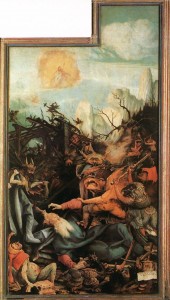Der Krieg (the war) by Otto Dix
When I think about German Expressionism the Isenheim Altarpiece (1506 -1515) by Matthias Grünewald comes quickly to my mind. I know that it isn’t exactly an Expressionist painting (I’m aware of the anachronism), but all expressionism (and some Surrealism too: Max Ernst, for instance) is there already.
One of the topics explored by Matthias Grünewald in his altarpiece is ergotism, as we can see in the polyptych’s wing shown below:
It represents Saint Anthony being harassed by demons, but if you look closely on the lower left corner of the painting you will see a patient afflicted with Saint Anthony’s fire. This disease was caused by the ingestion of ergot infected rye and other cereals. Ergotism produces seizures and hallucinations (hence the demons) as well as gangrene of the limbs and peeling. Ergotism also explains the strange look of Matthias Grünewald’s Christ in the aforementioned altarpiece. There was a spiritual connexion between the son of God’s suffering and the suffering of the diseased.
The depiction of human pain (often psychological pain instead of physical agony) isn’t the only theme explored by Expressionist painters (and it certainly isn’t this artistic movement’s monopoly), but it certainly is an important part of the aforementioned style. Otto Dix remembered Matthias Grünewald and the polyptich form (a tryptich with a predella: a gallery comic) when he painted Trench Warfare, 1929 – 1932, his own version of human suffering in WWI:


